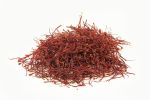If you like your spices gold-colored and expensive, find some fresh Crocus sativus flowers and grab ‘em by the…disproportionately large female reproductive organ. Small hands might work best, though it might turn your skin orange. Saffron is probably from the Middle East. If that bothers you, you may want to ban it from your spice shelves, however ill that bodes for the quality of your cabinet. After all, there is a stigma against that sort of thing.
The most expensive oversized reproductive organ in the world

A pile of dried saffron stigmas (“threads”). Photo from Wikipedia
You may know that saffron is the most expensive spice in the world. A Spanish farmer sold his crop of high quality saffron this year for four euros per gram, which is a ninth of today’s price of gold (36 euros per gram). Saffron is expensive because its production requires a huge amount of labor and land. Saffron production is labor- and land-intensive because saffron is a botanically unique food item that defies mechanical harvest and accounts for a miniscule proportion of the plant that bears it. The saffron threads sold as spice are the dried stigmas of the flowers of the saffron crocus (Crocus sativus, family Iridaceae). Recall that the stigma is the part of the flower’s female reproductive organs that catches pollen. Pollen travels from the stigma through the style into the flower’s ovary (collectively, the stigma, style, and ovary comprise the pistil). Continue reading

